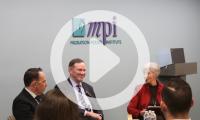Postsecondary Education
Recent Activity

This Migration Policy Institute Europe webinar examines possible scenarios for how social, economic, and technological trends could affect jobs, labor market policy, education and social policies, and migrant integration. Speakers also explored the potential of coding schools for refugees to help alleviate skills shortages and provide a pathway to work.

Marking the release of a report on the barriers foreign-trained high-skilled immigrants face in the United States, this webinar examines programs and initiatives that assist with credential recognition, employment, and relicensure, as well as recent policy developments. Discussants review recommendations for community-based organizations, employers, and policymakers to expand successful efforts aimed at preventing brain waste.

As the Trump administration assumes office and the DACA program faces an uncertain future, University of California President Janet Napolitano; Donald Graham, cofounder of TheDream.Us; and Ike Brannon, Visiting Fellow at the CATO Institute join MPI's Doris Meissner for a discussion on the possible impacts of rescinding DACA, particularly in the areas of higher education, philanthropy, and the economy.

A presentation of the first-ever U.S. estimates on the economic costs of brain waste for highly skilled immigrants, their families, and the U.S. economy. The researchers discuss their findings in terms of the billions of dollars in forgone earnings and unrealized taxes when college-educated immigrants are relegated to low-skilled work.

Nearly 2 million college-educated immigrants in the United States are stuck in low-skilled jobs or are unemployed—a phenomenon known as brain waste. In this brief video, MPI researchers discuss their key findings on immigrant skill underutilization and the resulting billions of dollars in unrealized wages and forgone federal, state, and local tax receipts.
Pages
Recent Activity
Some of the strictest COVID-19 pandemic-era limits on human mobility occurred in the Asia Pacific region. Border closures started in East and Southeast Asia in early 2020 and quickly spread through the entire region, in some cases remaining in place for more than two years. This report examines the approaches countries took and reflects on the immense costs and benefits of using border measures to tackle public-health risks.


















Investing in the Future: Higher Ed Should Give Greater Focus to Growing Immigrant-Origin Student Population
Narrowing the Skills Gap: Equipping Immigrant-Origin Workers with Postsecondary Credentials
A Deeper Look at the DREAMers Who Could Feature in the Legalization Debate in Congress
As U.S. Health-Care System Buckles under Pandemic, Immigrant & Refugee Professionals Could Represent a Critical Resource
More Than a DREAM (Act), Less Than a Promise
The Diversity Visa Program Holds Lessons for Future Legal Immigration Reform
All Eyes Turn to Congress, Following Trump Decision to Terminate DACA Program
Immigrants and the New Brain Gain: Ways to Leverage Rising Educational Attainment
Mapping the Patchwork of State ‘DREAM Acts’ and Postsecondary Education Policies for Unauthorized Immigrant Youth
County-Level View of DACA Population Finds Surprising Amount of Ethnic & Enrollment Diversity
Pages